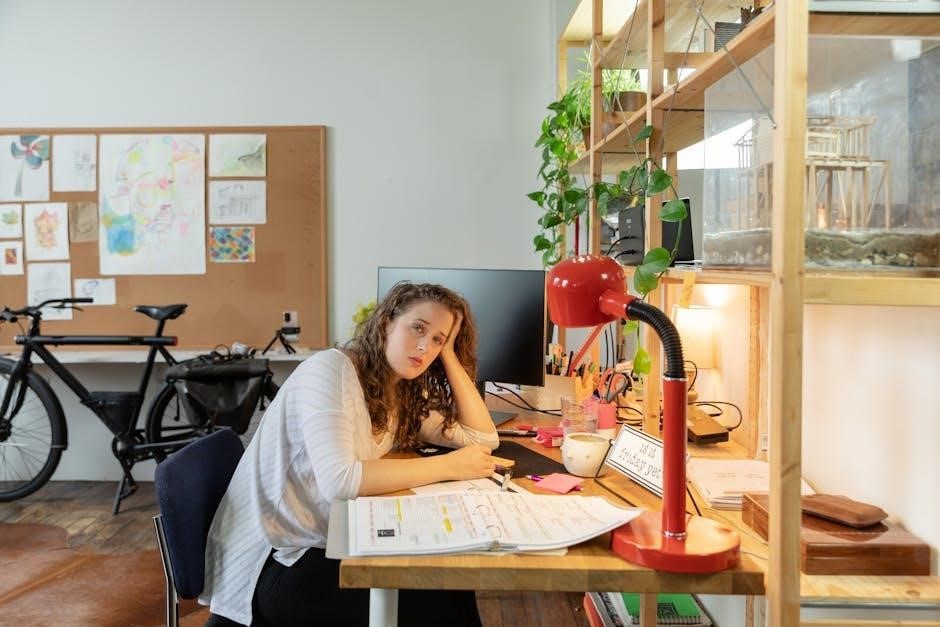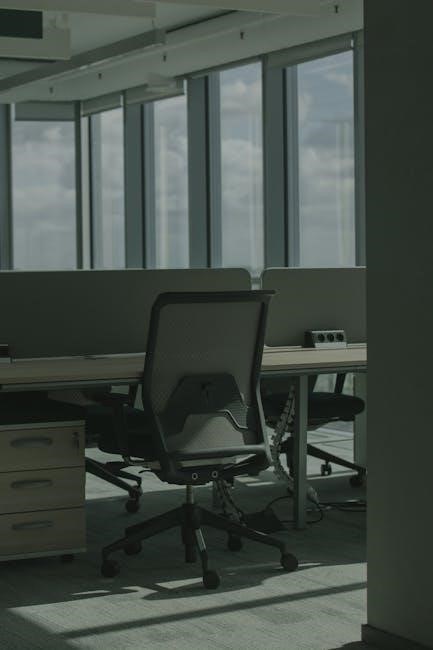Steelcase cubicle disassembly is a multi-step process requiring careful planning and the right tools. It involves dismantling panels, frames, and components for relocation or reconfiguration. Essential tools include screwdrivers and wrenches, while safety and organization are key to avoiding damage. Proper disassembly ensures components remain intact for future use or storage.
1.1 Overview of Steelcase Cubicles
Steelcase cubicles are modular workspaces designed for flexibility and durability. They feature adjustable panels, frames, and storage solutions, offering customization for various office needs. Known for their robust construction, these cubicles are popular in modern workplaces. Their design emphasizes ergonomic comfort and adaptability, making them suitable for different work environments and preferences. Understanding their structure is key to effective disassembly and reassembly.
1.2 Importance of Proper Disassembly
Proper disassembly of Steelcase cubicles ensures safety, prevents damage to components, and facilitates efficient reassembly. It minimizes risks of injury and structural compromise, while maintaining the integrity of parts for future use. Correct techniques also save time and resources, ensuring a smooth process for relocation or reconfiguration. Neglecting proper methods can lead to costly repairs or render components unusable.

Tools and Equipment Required
Essential tools include screwdrivers (flathead and Phillips), wrenches, and Allen keys. Optional tools like power drills may be needed for specific models. Proper equipment ensures safe disassembly.
2.1 Essential Tools for Disassembly
The essential tools for Steelcase cubicle disassembly include a flathead screwdriver, Phillips-head screwdriver, and an Allen wrench. These tools are necessary for removing screws and bolts from various components. Additionally, a rubber mallet can be useful for gently tapping parts apart without causing damage. Proper tools ensure efficient and safe disassembly, preventing damage to the cubicle parts or injury to the person disassembling.
2.2 Optional Tools for Specific Models
Optional tools for specific Steelcase cubicle models include a power drill, impact driver, or breaker bar for stubborn bolts. A pry bar may be needed for tightly fitted panels, while a torque wrench ensures precise bolt removal without stripping. These tools enhance efficiency but are not always necessary, depending on the cubicle model and condition.

Safety Precautions
Always wear safety glasses and gloves when disassembling Steelcase cubicles. Ensure the workspace is clear and stable to prevent accidents. Handle heavy components with care.
3.1 General Safety Guidelines
Always wear protective gear like gloves and safety glasses to prevent injuries. Ensure the workspace is well-lit and clear of obstacles. Secure cubicle components firmly to avoid sudden collapse. Use tools correctly and avoid overexertion. Follow manufacturer guidelines and consider having a second person assist with heavy parts.
3.2 Handling Heavy Components
Always lift heavy components with a team to avoid personal injury. Use dollies or carts to transport large parts safely. Ensure components are securely fastened to prevent shifting during movement. Avoid using damaged equipment, as it may fail under weight. Clear the path of obstacles to prevent tripping or accidents.
Pre-Disassembly Preparation
Organize tools and materials beforehand. Protect the floor with covers. Ensure all parts are accessible and ready for disassembly. Safety first.
4.1 Clearing the Workspace
Clearing the workspace is essential for efficient disassembly. Move furniture, equipment, and obstructions away from the cubicle. Cover the floor with protective material to prevent damage. Ensure good lighting and ventilation. Double-check for any hidden cables or obstacles. Organize tools and materials within easy reach. A clean workspace reduces risks and ensures smooth progress during disassembly.
4.2 Labeling Components for Reassembly
Labeling components is crucial for efficient reassembly. Use color-coded labels or tags to identify parts and their corresponding sections. Assign numbers or letters to screws, bolts, and small hardware, storing them in labeled bags. Document the disassembly process with photos or notes to reference later. Organized labeling ensures accuracy and saves time during reassembly, preventing confusion and potential damage to components.
Disassembling the Cubicle Panels
Begin by removing connectors and fasteners securing the panels. Gently pry or unscrew components, taking care with glass or acrylic sections to avoid damage. Proceed methodically.
5.1 Removing Panel Connections
Start by identifying panel connections, typically secured with screws or clips. Use a screwdriver to remove screws or a flat tool for clips. Gently pry panels apart, ensuring all connectors are detached. Label components for easy reassembly. Handle glass or acrylic sections with care to prevent breakage. Work methodically to maintain organization and safety throughout the process. This step is crucial for successful disassembly.
5.2 Handling Glass or Acrylic Panels
Handle glass or acrylic panels with extreme care to avoid breakage. Use a soft cloth or gloves to prevent scratches. Check for any brackets or attachments and remove screws if necessary. Gently lift panels, ensuring they are secure during removal. Store them upright in a protected area to prevent damage. Avoid applying pressure on edges, as they may be sharp or prone to cracking.

Disassembling the Overhead Storage
Overhead storage disassembly involves removing shelves and bins, followed by detaching the frame. Use screwdrivers to release brackets, then carefully lower the frame to avoid damage.
6.1 Removing Shelves and Bins
To remove shelves and bins, start by clearing all items from the storage unit. Use a screwdriver to release the retaining clips or screws securing the shelves. Gently lift each shelf out of the frame, taking care not to damage the mounts. For bins, slide them out after removing any brackets or stops holding them in place. Ensure all components are labeled for easy reassembly later. Handle glass or acrylic shelves with extra caution to prevent breakage.
6.2 Detaching Overhead Frames
Detach overhead frames by first removing any retaining brackets or screws using a screwdriver or wrench. Carefully disconnect the frame from the cubicle structure by lifting or sliding it off its mounts. If the frame is heavy, use a second person or lifting tool for support. Once detached, set the frame aside and label its connection points for easy reassembly. Handle all components with care to avoid damage.
Disassembling the Work Surface
Remove screws securing the desk top, then lift it off. Disconnect any cables or wiring underneath. Handle the surface carefully to avoid damage during disassembly.
7.1 Removing the Desk Top
To remove the desk top, start by disconnecting all cables and wires. Use a flat-bladed screwdriver to remove screws securing the top. Gently pry the desk top from its frame, working carefully to avoid damage. Lift the top evenly, ensuring it’s free from any remaining attachments. Handle with care to prevent scratching or breaking the surface during removal.
7.2 Disconnecting Cables and Wiring
Before removing the work surface, disconnect all cables and wiring. Turn off power to the cubicle and unplug any electronic components. Use a screwdriver to release cable ties and carefully pull cords from their connectors. Label each cable for easy reconnection later. Store wires in a protective covering to prevent damage during disassembly or transportation.

Disassembling the Base and Frame
Remove the base panels by unscrewing them with a wrench or screwdriver. Detach the frame structure carefully to avoid damage, ensuring all bolts are fully loosened.
8.1 Removing the Base Panels
Begin by unscrewing the base panels using a flat-head screwdriver or wrench. Gently pry the panels away from the frame, ensuring not to bend or scratch them. Once loosened, carefully lift and set aside for storage or reassembly. This step requires patience to avoid damage, as these panels are often securely attached.
8.2 Detaching the Frame Structure
To detach the frame, start by removing the screws that secure it to the base. Use a wrench or screwdriver to loosen bolts carefully. Once detached, lift the frame gently to avoid bending or warping. Ensure all connectors and brackets are removed before setting the frame aside. Handle with care, as frames can be heavy and delicate.

Reassembling the Cubicle
Reassembly involves reversing disassembly steps, ensuring all components are securely reattached; Start with the base, then add panels, followed by the work surface and overhead storage. Align parts carefully to maintain stability and functionality, double-checking connections for proper fit and safety.
9.1 Reattaching the Frame and Base
Reattach the frame and base by aligning the pre-drilled holes and screw points. Use the original bolts and screws, ensuring they are tightened securely but not over-torqued. Double-check the frame’s stability to prevent wobbling. If panels were labeled during disassembly, refer to them for accurate placement. Ensure all connectors are snug and the structure stands level before proceeding to other components.
9.2 Reinstalling the Work Surface
Reinstall the work surface by aligning it with the frame’s mounting points. Secure it using the original screws or bolts, tightening evenly to avoid warping. Ensure the surface is level and stable before placing any items on it. Double-check alignment and tighten all connections firmly but avoid over-tightening. Ensure all cables and wiring are properly reconnected and organized beneath the surface for a clean setup.

Storage and Transportation Tips
Store disassembled parts in labeled, protective containers. Transport components securely, ensuring even weight distribution to prevent damage. Use padding for fragile items like glass panels.
10.1 Proper Storage of Disassembled Parts
Store disassembled Steelcase cubicle components in a dry, climate-controlled environment. Use sturdy, labeled boxes for small parts and cover larger items with protective padding. Avoid stacking heavy components to prevent damage. Organize parts by type or cubicle section for easy reassembly. Ensure all storage containers are securely sealed and clearly labeled for identification. Maintain an inventory list to track stored items efficiently.
10.2 Safe Transportation of Components
Ensure safe transportation of Steelcase cubicle parts by using a sturdy vehicle with adequate space. Secure components with straps or padding to prevent shifting and damage. Protect fragile items like glass panels with bubble wrap. Use dollies or handcarts for heavy parts. Check vehicle capacity and ensure all items are properly loaded. Assign a team to handle heavy or oversized components carefully during transit.
Troubleshooting Common Issues
Common issues during disassembly include stuck or damaged parts. Use a screwdriver to gently pry components loose. Apply lubricant if parts are stubborn. Avoid using excessive force to prevent further damage. If a part breaks, note its position for replacement during reassembly; Keep a set of spare screws handy to address any unexpected damage or missing hardware.
11.1 Dealing with Stuck or Damaged Parts
When encountering stuck parts, carefully assess the situation. Use a flathead screwdriver to pry components gently, avoiding excessive force. Apply penetrating oil to loosen stubborn connections. For damaged parts, mark their position and set them aside for replacement. If a part breaks, document its location for proper reassembly. Handle glass or acrylic panels with care to prevent further damage.
11.2 Resolving Alignment Problems
Alignment issues during disassembly can hinder progress. Use an Allen wrench to adjust bolts and ensure proper fit. Gently tap components with a rubber mallet to realign frames or panels. Check connections for correct orientation and tighten loose screws. If parts misalign, verify all clips and brackets are securely attached. Use shims if necessary to stabilize components temporarily.

Disposal and Recycling Options
Dispose of Steelcase cubicle materials responsibly by recycling metal and fabric parts. Donate reusable components or repurpose them creatively. Always follow local recycling guidelines to ensure eco-friendly disposal.
12.1 Responsible Disposal of Materials
When disposing of Steelcase cubicle materials, prioritize eco-friendly methods. Separate metals, plastics, and fabrics for recycling. Donate intact components to local charities or reuse them in creative projects. Avoid landfill disposal to minimize environmental impact. Check with local recycling centers for specific guidelines on handling different materials responsibly. Proper disposal ensures sustainability and reduces waste effectively.
12.2 Recycling Steelcase Cubicle Components
Recycling Steelcase cubicle components is environmentally responsible and promotes sustainability. Metal frames, plastic parts, and fabric panels can be recycled through specialized facilities. Contact local recycling centers to determine acceptable materials and procedures. Proper recycling reduces landfill waste and conserves resources. Steelcase encourages eco-friendly practices, aligning with their commitment to sustainability. Ensure components are clean and sorted before recycling to maximize their reuse potential effectively.

Comparing Steelcase Cubicle Models
Steelcase cubicle models vary in design, materials, and disassembly complexity. Comparing models helps identify differences in frame structures, panel types, and hardware, aiding in tailored disassembly approaches.
13.1 Differences in Disassembly Processes
Different Steelcase models require varied disassembly techniques. The Series 1 and 2 often involve removing screws and clips, while the Leap and Think models may have unique mechanisms. Panels, frames, and storage units vary in how they detach, necessitating model-specific tools and strategies to ensure safe and efficient disassembly without damaging components.
13.2 Model-Specific Disassembly Tips
Steelcase models vary in disassembly requirements. The Series 1 may need specific screwdrivers for panel removal, while the Series 2 might require detaching frames first. The Leap chair involves prying headrest arms, and Think chairs use unique fasteners. Always consult model-specific guides to avoid damage and ensure smooth disassembly, as techniques differ across product lines.
Time-Saving Disassembly Techniques
Streamline disassembly by using power tools for faster screw removal. Organize components in labeled containers to simplify reassembly and reduce downtime efficiently.
14.1 Streamlining the Disassembly Process
Plan the disassembly sequence to minimize steps and time. Use power tools for quick screw removal and organize components as you go. Start with overhead storage to avoid damaging work surfaces. Labeling parts immediately ensures efficient reassembly. Consider disassembling panels from the top down to prevent component misplacement and reduce overall effort required.
14.2 Using Power Tools Effectively
Power tools like cordless drills and impact wrenches significantly speed up disassembly. Use them for removing screws and bolts quickly and efficiently. Always wear safety goggles and ensure tools are set to appropriate torque to avoid damaging components. Regularly organizing disassembled parts as you go helps maintain workspace clarity and prevents losing small hardware pieces.

Common Mistakes to Avoid
Avoid applying excessive force, which can damage components. Never overlook safety protocols, as this can lead to accidents or injuries during disassembly.
15.1 Avoiding Damage to Components
Use the correct tools to prevent scratching or bending parts. Avoid excessive force, which can break connectors or frames. Handle glass panels with care to prevent shattering. Store disassembled parts in a safe, dry area to avoid rust or damage. Use protective coverings for sensitive surfaces and ensure all components are securely fastened during reassembly to maintain structural integrity.
15.2 Preventing Safety Hazards
Always wear protective gear like gloves and safety glasses to protect against sharp edges or falling debris. Ensure the workspace is clear to prevent tripping. Use proper lifting techniques to avoid injury when handling heavy components. Keep tools organized to minimize accidental cuts or punctures. Never leave unstable structures standing during disassembly, as they may collapse and cause harm.
Steelcase cubicle disassembly requires careful steps. Post-disassembly, inspect all components for damage and ensure proper storage. Labeling and organization are key for future reassembly or transport.
16.1 Final Inspection of Disassembled Parts
After disassembling, inspect each component for damage or wear. Check fasteners, panels, and frames for integrity. Ensure all parts are clean and free from debris. Properly label and organize components to prevent loss or damage during storage or transport. This step ensures readiness for reassembly or disposal, maintaining the value of Steelcase cubicle parts.
16.2 Ensuring Readiness for Reassembly or Storage
Organize and label all disassembled parts securely. Use protective materials like bubble wrap for fragile components. Store items in sturdy boxes or containers, ensuring they are dry and clean. Verify all components are accounted for and properly sealed. This preparation ensures efficient reassembly or safe transportation, maintaining the integrity of Steelcase cubicle parts for future use.
